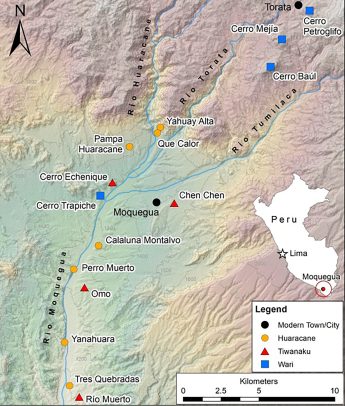‘X-ray gun’ informs compositional analysis of Peruvian artifacts
A University of Illinois Chicago archeologist and colleagues used an “X-ray gun” to examine ancient obsidian artifacts from Peru, and in a newly published article, they report on the region’s cultural interactions and systems of exchange.
In a paper in the Journal of Archaeological Science: Reports, David Reid and colleagues detail how they used portable X-ray fluorescence to trace the movement of obsidian artifacts across the Andes to the Middle Moquegua Valley during the Middle Horizon period over 1,000 years ago.
A total of 50 obsidian artifacts housed in the Museo Contisuyu in Moquegua, Peru, were analyzed from 10 archaeological sites affiliated with Tiwanaku, Wari and indigenous Huaracane groups across the Formative Period and Middle Horizon eras (C.E. 600-1000).
Notably, their analysis finds obsidian tools and materials crossed social boundaries between the expansive Tiwanaku and Wari states along their only known shared frontier in Moquegua.
“This study demonstrates that even when state colonists maintain strict cultural identities tied to homeland regions, such rigid social boundaries are rarely impermeable, and social networks may cross-cut traditional divisions,” said Reid, UIC postdoctoral research associate in anthropology.
Over half of the obsidians utilized by Tiwanaku were found to correspond with Wari-affiliated sources.
The exchange between expansionary states likely occurred due to sociopolitical factors, according to the researchers, who also note that further investigation is needed to determine whether this exchange was through peaceful trade and social interaction, scavenging, plunder or even literal “exchanges” of arrows in volleys.
Co-authors of the study are Paul Goldstein of the University of California, San Diego, and Patrick Ryan Williams of UIC and the Field Museum of Natural History.
This work was supported by funding obtained by Goldstein from the Fulbright-Hays, Wenner Gren, HJ Heinz III foundations and National Science Foundation awards (9809720 and 1067986). Assistance was also received via the Elemental Analysis Facility at the Field Museum, which has been funded by the W. W. Grainger Foundation, the Negaunee Foundation and the National Science Foundation (BCS-1628026, 1531394, 1321731, 0818401, and 0320903).

